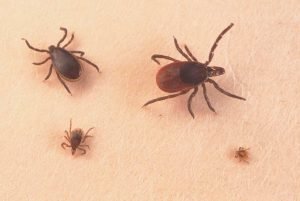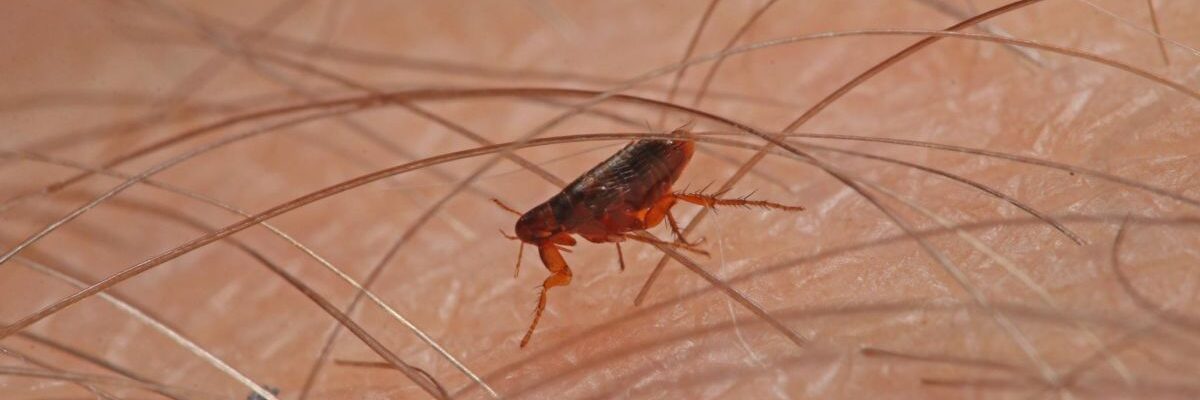Summary
Typhus fever is a type of bacterial infection transmitted by lice, fleas, ticks, and mites carrying Rickettsia bacteria. When these parasites bite, they can introduce the bacteria into the body, leading to symptoms such as fever, headache, muscle chills, and rash.
Typhus fever is distinct from typhoid fever, although the names sound similar, and both are bacterial infections. Typhus is caused by Rickettsia bacteria transmitted by small parasitic insects, whereas typhoid fever is caused by Salmonella bacteria, typically contracted through contaminated food or water. Both diseases are more prevalent in regions with poor sanitation, such as parts of Africa and Asia, and typhus is common in tropical climates.
Treatment for typhus fever requires antibiotics, usually over a course of seven to ten days. Patients with mild symptoms may be able to recover at home under medical supervision, but severe cases often require hospitalization for closer monitoring and care. Prompt treatment is essential, as untreated typhus can lead to serious complications, especially in vulnerable populations.
Table of Contents
Symptoms of Typhus Fever

The symptoms of each type of typhus fever can vary, but certain symptoms are commonly present across all types:
- Fever
- Rash
- Headache
- Muscle chills
Symptoms of Epidemic Typhus
- Severe headache. Patients experience intense, persistent headaches.
- High fever. Fever is typically very high and sustained.
- Rash that starts on the back or chest. This rash can spread across the body as the infection progresses.
- Confusion or delirium. Mental disorientation and confusion may occur in severe cases.
- Low blood pressure (hypotension). Blood pressure may drop, leading to weakness.
- Sensitivity to light. Patients may find bright lights uncomfortable.
- Severe muscle pain. Muscle pain can be debilitating.
Symptoms of Murine or Endemic Typhus
Murine typhus has symptoms similar to epidemic typhus but is generally milder. Additional symptoms of murine typhus may include:
- Dry cough. Patients may experience a persistent cough without mucus.
- Nausea or vomiting. Digestive symptoms such as nausea are common.
- Diarrhea. Digestive issues may include frequent loose stools.
Symptoms of Scrub Typhus
Scrub typhus presents with unique symptoms, including:
- Rash, particularly at the bite site. The rash often starts where the infected mite bit the skin.
- Swollen lymph nodes. Enlarged lymph nodes are common as the body fights the infection.
- Cough. Respiratory symptoms like cough are typical.
- Extreme fatigue. Fatigue may be intense, even with minimal activity.
Symptoms of Spotted Fever
Spotted fever symptoms include:
- High fever. Fever is often sudden and intense.
- Muscle chills. Patients may experience chills throughout the body.
- Severe headache and muscle pain. Pain in the head and muscles is common.
- Nausea or vomiting. Digestive symptoms like nausea may occur.
- Confusion. Mental disorientation can appear in severe cases.
Diagnosing typhus can be challenging, as symptoms often resemble those of other infections like dengue, malaria, and brucellosis. To confirm typhus, patients may undergo diagnostic tests such as skin biopsy, Western blot, and immunofluorescence testing, which help identify the presence of Rickettsia bacteria. Early and accurate diagnosis is essential for effective treatment, particularly in severe cases.
Types of Typhus Fevers

Typhus has several types, classified based on the parasite that transmits the bacteria to humans. These include:
- Epidemic typhus. This type of typhus is transmitted by body lice infected with Rickettsia prowazekii bacteria. Epidemic typhus is most common in overcrowded, unsanitary conditions and can spread quickly in areas where people are in close contact.
- Murine or endemic typhus. Endemic typhus is transmitted by fleas that live on rodents, especially rats. The bacteria responsible, Rickettsia typhi, infects humans when flea bites introduce the bacteria into the bloodstream. This form of typhus is generally milder than epidemic typhus and is more common in warm, coastal areas.
- Scrub typhus. Caused by Orientia tsutsugamushi bacteria, scrub typhus is transmitted by mite bites (also known as chiggers), often from mites that live on rodents or in vegetation. It is commonly found in rural areas of Southeast Asia, the Western Pacific, and Australia.
- Spotted fever. Known by names such as Boutonneuse fever, Rocky Mountain spotted fever, and Queensland tick typhus, this type is transmitted by ticks carrying Rickettsia bacteria from the spotted fever group. Spotted fever is more prevalent in North and South America, Europe, and parts of Australia.
Each type of typhus has distinct characteristics and transmission methods but shares similar symptoms. Understanding the different types helps in prevention, as each form is linked to specific vectors and environments.
Diagnostic Procedures for Typhus Fever
Diagnosing typhus fever accurately is essential for effective treatment, as its symptoms can resemble other infections. Here are the main diagnostic procedures used to confirm typhus fever:
- Blood tests. Blood tests are commonly used to detect typhus fever, as they can reveal antibodies the immune system produces in response to Rickettsia bacteria. These antibodies typically appear within a week after infection.
- Polymerase Chain Reaction (PCR) test. PCR testing detects the DNA of Rickettsia bacteria in a blood sample, allowing for early detection. This is one of the most precise tests for confirming typhus infection, especially in the early stages.
- Indirect Immunofluorescence Assay (IFA). IFA is considered the gold standard for typhus diagnosis. This test uses fluorescent dyes to detect specific antibodies against Rickettsia bacteria, providing confirmation of infection.
- Skin biopsy. In cases where a rash is present, a skin biopsy can be taken from the rash area. The biopsy sample can then be examined under a microscope to identify Rickettsia bacteria, helping to confirm typhus fever.
- Western blot test. The Western blot test is used to detect antibodies specific to Rickettsia proteins in the blood. This test is particularly useful when other tests are inconclusive, as it helps distinguish typhus from other infections with similar symptoms.
Early and accurate diagnosis is critical to begin prompt antibiotic treatment, as typhus can lead to severe complications if left untreated.
Complications of Untreated Typhus Fever
If left untreated, typhus fever can lead to serious and potentially life-threatening complications, particularly in vulnerable individuals such as the elderly or those with weakened immune systems. Here are some of the major complications associated with untreated typhus fever:
- Severe pneumonia. The infection can spread to the lungs, causing pneumonia, which results in difficulty breathing, chest pain, and reduced oxygen levels. Severe pneumonia may require hospitalization and intensive respiratory support.
- Hepatitis. Typhus can lead to liver inflammation (hepatitis), causing symptoms such as jaundice, abdominal pain, and liver dysfunction. Hepatitis can worsen if not managed and may result in liver damage over time.
- Kidney failure. Untreated typhus can impair kidney function, sometimes leading to acute kidney failure. In severe cases, kidney failure may necessitate dialysis to filter waste from the blood.
- Myocarditis. The infection can inflame the heart muscle (myocarditis), disrupting the heart’s ability to pump blood efficiently. This can lead to irregular heart rhythms and, in severe cases, heart failure.
- Central nervous system complications. Typhus can affect the brain and central nervous system, leading to encephalitis (brain inflammation), confusion, seizures, and in severe cases, coma. Neurological complications are particularly dangerous and may cause long-term damage.
- Sepsis. In some cases, the infection may spread throughout the body, leading to sepsis—a potentially fatal response to infection that causes widespread inflammation, organ failure, and dangerously low blood pressure.
- Gangrene. In advanced cases, typhus can disrupt blood flow to the extremities, leading to tissue death (gangrene). This is a rare but serious complication that may require amputation of the affected area.
Due to the high risk of complications, early diagnosis and treatment of typhus with antibiotics are essential. Timely medical intervention can prevent the progression of these serious health issues and improve the chances of a full recovery.
Causes of Typhus Fever

The primary cause of typhus is infection with Rickettsia bacteria, which can be transmitted through bites from certain parasitic insects:
- Lice
- Fleas
- Ticks
- Mites
Not all of these parasites carry Rickettsia bacteria, but it is still essential to avoid bites as a precaution. Parasites that carry Rickettsia can transmit the bacteria when they bite, potentially leading to different types of typhus fever. Taking measures to prevent bites from these insects can significantly reduce the risk of typhus, especially in areas where these parasites are prevalent.
Prevention of Typhus Fever
In the past, researchers developed a vaccine to prevent typhus. However, due to declining cases, vaccine production was eventually discontinued. Even so, the following steps are recommended to reduce the risk of contracting typhus:
- Maintain personal hygiene to avoid lice infestations. Regularly wash and groom hair to remove lice and nits. If lice are present, comb the hair with a fine-toothed comb or, if necessary, cut the hair short and apply pediculicide shampoo specifically designed to kill lice and nits.
- Remove fleas and ticks from pets. Use special pet shampoos, soaps, and medications that are safe for animals to eliminate fleas and ticks, which can transmit Rickettsia bacteria to humans.
- Keep surroundings clean to discourage rodents. Rats often carry fleas and ticks, which are common typhus vectors. Ensure a clean environment to avoid rodent infestations. If rodents are present, rodenticides and mouse traps can help control the population.
- Avoid traveling to areas with high rates of active typhus cases. If travel to such areas is unavoidable, consider taking chemoprophylaxis as prescribed by a healthcare provider. Chemoprophylaxis is preventive medication that can help reduce the risk of infections like typhus.
- Avoid handling animals with fleas and ticks. Not only could you be bitten, but parasites could also transfer to your clothing without you realizing it.
- Avoid sharing personal items such as combs, blankets, clothing, or towels. These items could harbor lice or nits, potentially leading to an infestation.
By following these preventive measures, individuals can significantly reduce the risk of contracting typhus, especially in regions where the disease is more common. Maintaining cleanliness and taking care around animals and personal items are effective ways to protect against infection.
Risk Factors for Typhus Fever
The likelihood of contracting typhus can increase due to the following factors:
- Traveling or vacationing in areas where typhus is prevalent. Visiting regions with high rates of typhus cases raises the risk of exposure to infected parasites.
- Living in overcrowded areas with poor sanitation. Crowded and unsanitary conditions provide an environment where lice, fleas, and ticks can thrive, increasing the risk of infection.
- Residing in areas with a high population of animals. Areas with large numbers of rodents or other animals are more likely to have fleas and ticks, which can carry the bacteria that cause typhus.
- Frequent contact with individuals with poor personal hygiene. Close contact with people who may have lice or fleas can increase the risk of contracting typhus.
- Handling animals with fleas and ticks. Direct contact with animals carrying these parasites, especially pets or livestock, can transmit Rickettsia bacteria.
- Having lice in the hair or scalp. Head lice, in particular, can increase the chance of typhus infection if they are carrying Rickettsia bacteria.
- Visiting mountainous or rural areas with many ticks. Ticks in certain regions are known carriers of typhus bacteria and can transmit the infection through their bites.
These risk factors are particularly relevant in environments where hygiene and animal control are limited. Reducing exposure to parasites, maintaining personal and environmental cleanliness, and taking precautions when in high-risk areas can help lower the risk of typhus.
Typhus Fever FAQs
Here are some frequently asked questions about typhus fever, covering its causes, symptoms, prevention, and treatment.
- What is typhus fever?
Typhus fever is a bacterial infection caused by Rickettsia bacteria, typically transmitted by parasites such as lice, fleas, ticks, and mites. Typhus comes in different forms, including epidemic typhus, murine (endemic) typhus, scrub typhus, and spotted fever. - How is typhus transmitted?
Typhus is spread when an infected parasite bites a person, transferring Rickettsia bacteria into the bloodstream. It can also spread through contact with infected animal hosts, particularly rodents, which carry fleas that may transmit the bacteria. - What are the symptoms of typhus fever?
Symptoms include fever, headache, muscle pain, chills, rash, fatigue, and sometimes nausea. In severe cases, typhus can cause confusion, breathing difficulties, and organ inflammation. - How long does it take for symptoms to appear?
The incubation period for typhus is usually 5 to 14 days after exposure. During this time, there may be no visible symptoms, but the bacteria are actively multiplying in the body. - How is typhus diagnosed?
Diagnosis is confirmed through blood tests that detect antibodies against Rickettsia bacteria, PCR tests that identify bacterial DNA, or skin biopsy in cases with a rash. Tests like the Indirect Immunofluorescence Assay (IFA) are often used to confirm infection. - Can typhus be treated?
Yes, typhus can be treated with antibiotics, typically doxycycline. Early treatment is essential to prevent complications. Most patients recover fully with timely medical care. - What complications can arise if typhus is left untreated?
Untreated typhus can lead to serious complications, including pneumonia, liver inflammation, kidney failure, myocarditis, brain inflammation, and, in severe cases, sepsis or gangrene. Prompt treatment can reduce the risk of these complications. - How can I prevent typhus?
Prevention includes maintaining personal hygiene, reducing exposure to lice, fleas, and ticks, and avoiding direct contact with wild animals, particularly rodents. In high-risk areas, using insect repellents and keeping living spaces clean can help minimize the risk. - Can typhus spread from person to person?
Typhus does not typically spread directly from person to person. Instead, it is transmitted through bites from infected parasites. However, close contact in unsanitary conditions can increase the risk of infestation and spread within groups. - Is there a vaccine for typhus?
Currently, there is no vaccine for typhus. Although a vaccine was previously developed, it was discontinued due to decreasing cases. Prevention focuses on hygiene, pest control, and prompt medical care if symptoms appear.


